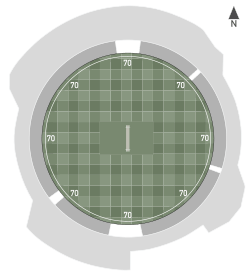Wankhede Stadium
The Wankhede Stadium (Marathi: वानखेडे स्टेडियम) is an international cricket stadium in Mumbai, India. The stadium now has a capacity of 33,108, following renovations for the 2011 Cricket World Cup. Before the upgrade, the capacity was approximately 45,000.[2]
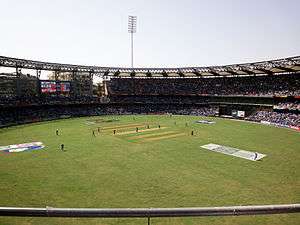 Wankhede Stadium during the first innings of the 2011 Cricket World Cup Final between Sri Lanka and India | |||||||||||||||||||||||||||||||||||||
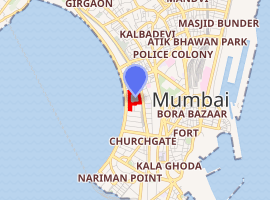
| |||||||||||||||||||||||||||||||||||||
| Address | India | ||||||||||||||||||||||||||||||||||||
|---|---|---|---|---|---|---|---|---|---|---|---|---|---|---|---|---|---|---|---|---|---|---|---|---|---|---|---|---|---|---|---|---|---|---|---|---|---|
| Location | Mumbai, India | ||||||||||||||||||||||||||||||||||||
| Operator | Mumbai Cricket Association | ||||||||||||||||||||||||||||||||||||
| Capacity | 33,108 (2011-present) 45,000 (1974-2010) | ||||||||||||||||||||||||||||||||||||
| Construction | |||||||||||||||||||||||||||||||||||||
| Architect | Shashi Prabhu and Associates (1974) Shashi Prabhu and Associates and P.K. Das and associates (2017) | ||||||||||||||||||||||||||||||||||||
| |||||||||||||||||||||||||||||||||||||
The Wankhede stadium has been host to numerous high-profile cricket matches in the past, most notable being the 2011 Cricket World Cup Final, in which India defeated Sri Lanka and became the first country to win the cricket world cup on home soil. The stadium witnessed the last match of Sachin Tendulkar's international career. Additionally, it has hosted many other matches in both the 1996 as well as the 2011 Cricket World Cup. The stadium is also the host to the match in which Ravi Shastri hit six sixes in an over. As of 14 January 2020, it has hosted 25 Tests, 21 ODIs and 7 T20Is.
Early years
Mumbai has seen Test matches played at three different grounds. The Bombay Gymkhana ground hosted the first-ever Test in India, in 1933–34 against England. After World War II, the Cricket Club of India Ltd's Brabourne Stadium – second ground of the city – was used for 17 Tests. The Wankhede Stadium was built after disputes between the Cricket Club of India, which owns the Brabourne Stadium, and the Bombay Cricket Association (now Mumbai Cricket Association) over the allocation of tickets for cricket matches.[3] This became severe after the Test between India and England in 1973. At the initiative of S. K. Wankhede, a politician and the secretary of the Bombay Cricket Association, BCA built the new stadium in South Bombay (now South Mumbai) near the Churchgate station. It was built in approx. six months and opened in time for the final Test between India and the West Indies in 1975.[1] Since then the Wankhede stadium has taken over from Brabourne Stadium as the main cricketing venue in the city. It was named after the Association’s President Barrister Sheshrao Wankhede in 1974.
It staged its first Test in the 1974–75 season when the West Indies toured India. Clive Lloyd scored an unbeaten 242 and in Pataudi's last hurrah, India lost by 201 runs. The Test also featured a crowd disturbance after a fan who rushed onto the ground to greet Lloyd was treated roughly by the police. India's first victory here was posted against the New Zealand two seasons later. The stadium has been a witness to great innings like Sunil Gavaskar's 205 against the West Indies and Alvin Kallicharan's 187 in the same game in the 1978–79 series and all-round heroics like Ian Botham's century and thirteen wickets in the Jubilee Test in 1979–80, which England won by ten wickets. The highest score by an Indian at the Wankhede Stadium is Virat Kohli's 235 against England in 2016-17. Incidentally Ravi Shastri's six sixes in an over off Baroda's Tilak Raj in Ranji Trophy, en route to the fastest double-hundred in first-class cricket were recorded on this ground in 1984–85. His unbeaten 200 in 113 minutes off 123 balls with 13 fours and 13 sixes at this ground is the fastest double century in first-class cricket since 2017-18 season when Shafiqullah Shafaq scored double century in 89 balls.[4]
Stadium development
The Wankhede Stadium was built in 1975 and the first Test match played was between India and West Indies from 23 to 28 January 1975. The Stadium was built at a time when only Test Matches were played and with the advent of One Day Cricket and Twenty 20 Cricket, the demands of a Stadium from a spectator's point of view have totally changed.
Since ICC World Cup Cricket 2011 was to be hosted by India, Bangladesh and Sri Lanka, and Mumbai was selected to host the final, it was decided to redevelop the Wankhede Stadium to suit the modern facilities and comfort of spectators.
The Managing Committee invited presentations from reputed Architects and shortlisted M/s. P.K. Das & Associates and M/s. Shashi Prabhu & Associates to jointly draw up a project for the redevelopment of the Wankhede Stadium. While redeveloping the Stadium, major changes were at the North end and the South end with better facilities to the spectators in terms of bucket seating, a large number of toilets and food courts.
While MCA undertook the redevelopment of Wankhede Stadium, the ground was not available for domestic and international cricket till February 2011. In order to ensure that MCA did not miss out on the turn of Test and ODI matches and also to develop a healthy working relationship with the Cricket Club of India.
One of the highlights of the stadium is the suspended cantilever roofs. The Teflon fabric roof is lighter in weight and heat resistant. There is no beam support for the roof to ensure that the spectators will have a better view. On the roof, there are exhaust fans which suck the hot air from the stands and allow the breeze from the West to flow in. The stadium has 20 elevators for North and South stands. [5]
Pitch
The seaside situation of the Wankhede stadium means that the swing bowlers get a fair amount of assistance during the early part of each day. Red soil is used to prepare the pitch, which ensures consistent bounce. Pitch has always been a slow turner. Most of the time it is made result-oriented. It has traditionally been full of runs, but it does help the spinners during the last couple of day, and in the Test played on the ground, against Australia in 2004 the ball spun viciously from early on and this, coupled with low bounce, helped India win in under three days even though almost a whole day was lost to rain. The pitch has created many exciting games here with the test between India and West Indies in 2011 ending in a draw with both sides tied on equal runs. The most recent test match at the stadium was between India and England in 2016, when nearly all wickets taken by spinners. Still, the pitch was full of runs, witnessing 4 centuries, including a double century of the Indian captain, and innings total 400 and 600+ in the first inning of the teams only.
Ground facts and figures
- Capacity: 33,108
- Floodlights: Yes
- The WS is the home ground of Mumbai Indians team in Indian Premier League, as well as Mumbai's Ranji Trophy team.
- The ground is situated near Marine Lines in Mumbai.
Various format record
Test Records
- Highest total: 631-all out by India against England in the 2016/17 season.
- Lowest total: 93 by Australia against India in the 2004/05 season.
- The highest partnership at the Wankhede Stadium is 298 by DB Vengsarkar and RJ Shastri for India against Australia in the 1986/87 season.
- Sunil Gavaskar (1122 runs) has scored the most Test runs, followed by Sachin Tendulkar (921) and Dilip Vengsarkar (631).[6]
- Anil Kumble (38 wickets), R Ashwin (30 wickets) and Kapil Dev (28)[7]
ODI Records
- Highest total: 438/4 by South Africa against India in the 2015 One Day International Series, then 358/6 by New Zealand, 299/4 by India and Sri Lanka 289/7.[8]
- Lowest total: 115 all out by Bangladesh against India in the 1998 season.
- Sachin Tendulkar (455 runs) has scored the most ODI runs, followed by Mohammed Azharuddin (302) and Virat Kohli (249).
- Venkatesh Prasad (15 wickets), Anil Kumble (12) and Harbhajan Singh (9).
T20I Records
- Highest total: 240/3 by India against West indies in 11 dec 2019
- Lowest total: 135/7 by Sri Lanka against India on 24 Dec 2017(3rd match in 3 match t20 series).
- JE Root of England (131) has scored the most runs, followed by V Kohli of India (127), and CH Gayle of West Indies (104)
Stands
- Sunil Gavaskar Stand
- North Stand
- Vijay Merchant Stand
- Tendulkar Stand
- MCA Stand
- Vitthal Divecha Stand
- Garware Stand
- Grand Stand
Cricket World Cup
This stadium has hosted 20 One Day International (ODI) matches every time that India has hosted the Cricket World Cup:
1987 Cricket World Cup
1996 Cricket World Cup
Gallery
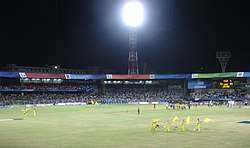 Chennai Super Kings Wins Vs Kings XI Punjab at Wankhede
Chennai Super Kings Wins Vs Kings XI Punjab at Wankhede Before renovation
Before renovation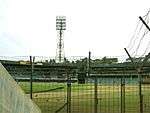 Before renovation
Before renovation Old entrance of the stadium
Old entrance of the stadium Before renovation, from the railway lines next to the stadium
Before renovation, from the railway lines next to the stadium Prime Minister Narendra Modi and the stadium in October 2014
Prime Minister Narendra Modi and the stadium in October 2014
References
- Inglis, Simon (25 May 2000). Sightlines: a stadium odyssey. Yellow Jersey. ISBN 978-0-224-05968-8. Retrieved 20 May 2012.
- Janardhan, Arun (17 October 2013). "Sachin's last Test: Wankhede braces for ticket rush". livemint.com. Retrieved 18 March 2018.
- "Cricinfo: Brabourne Stadium". ESPNcricinfo. Retrieved 5 March 2011.
- https://www.cricblogg.com/wankhede-stadium/
- "MCA: Wankhede Stadium". mumbaicricket.com. Retrieved 21 February 2012.
- "Records: Wankhede Stadium, Mumbai: Test matches: Most runs". ESPN Cricinfo. Retrieved 15 October 2016.
- "Records: Wankhede Stadium, Mumbai: Test matches: Most wickets". ESPN Cricinfo. Retrieved 15 October 2016.
- "Records: Wankhede Stadium, Mumbai: One-Day Internationals: Highest totals". ESPN Cricinfo. Retrieved 15 October 2016.
See also
External links
| Wikimedia Commons has media related to Wankhede Stadium. |
